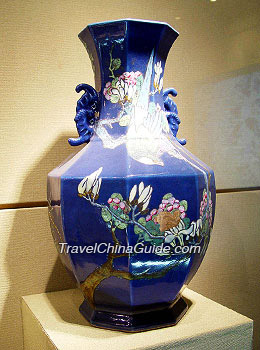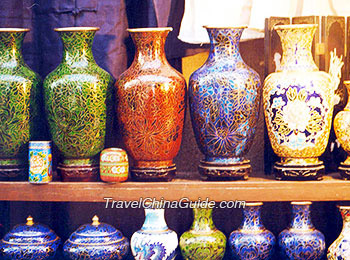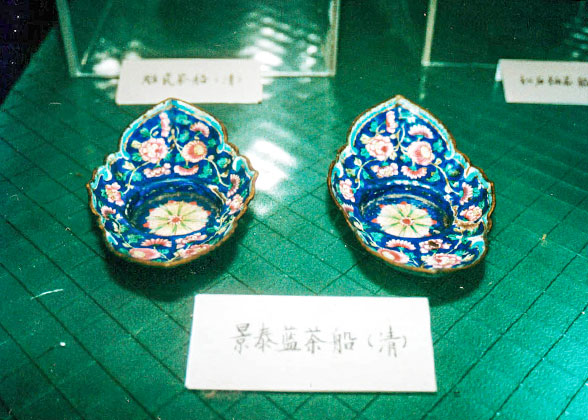Chinese Cloisonne (Jing Tai Lan)
General Introduction
 |
| Cloisonne Bottle |
Manufacture Procedure
Cloisonne manufacture is comprehensive and sophisticated, combining the techniques of making bronze and porcelain ware, as well as those of traditional painting and sculpture:
![]() Model Hammering: The process is to form copper pieces into various shapes with a hammer according to a design, joining them under high temperature.
Model Hammering: The process is to form copper pieces into various shapes with a hammer according to a design, joining them under high temperature.![]() Filigree Welding: In filigree welding the artist pinches and curves copper filigree into delicate flower patterns, pasting them onto the copper molds. Possibly the most challenging step of the procedure, heating to 900 degrees centigrade, firms the metal.
Filigree Welding: In filigree welding the artist pinches and curves copper filigree into delicate flower patterns, pasting them onto the copper molds. Possibly the most challenging step of the procedure, heating to 900 degrees centigrade, firms the metal.
![]() Enamel Filling: Through this interesting procedure, the cloisonne wears a colored wrap. Handicrafts specialists fill enamel glaze into lattices formed by fine-spun filigrees. Just one filling is not enough - the filigrees extrude, and the surface is dull. They have to fuse powdery glaze in the smelter at 800 degrees centigrade, then take the object out and repeat the process three or four times until its surface becomes smooth.
Enamel Filling: Through this interesting procedure, the cloisonne wears a colored wrap. Handicrafts specialists fill enamel glaze into lattices formed by fine-spun filigrees. Just one filling is not enough - the filigrees extrude, and the surface is dull. They have to fuse powdery glaze in the smelter at 800 degrees centigrade, then take the object out and repeat the process three or four times until its surface becomes smooth.
|
|
![]() Gilding: After acid pickling, fluid gold adds elegance and civility to a cloisonne piece.
Gilding: After acid pickling, fluid gold adds elegance and civility to a cloisonne piece.
Today this technique is associated with the sculpture of wood, jade, ivory and lacquer. Cloisonne art is exported to many countries as a favorite medium for ornaments.

